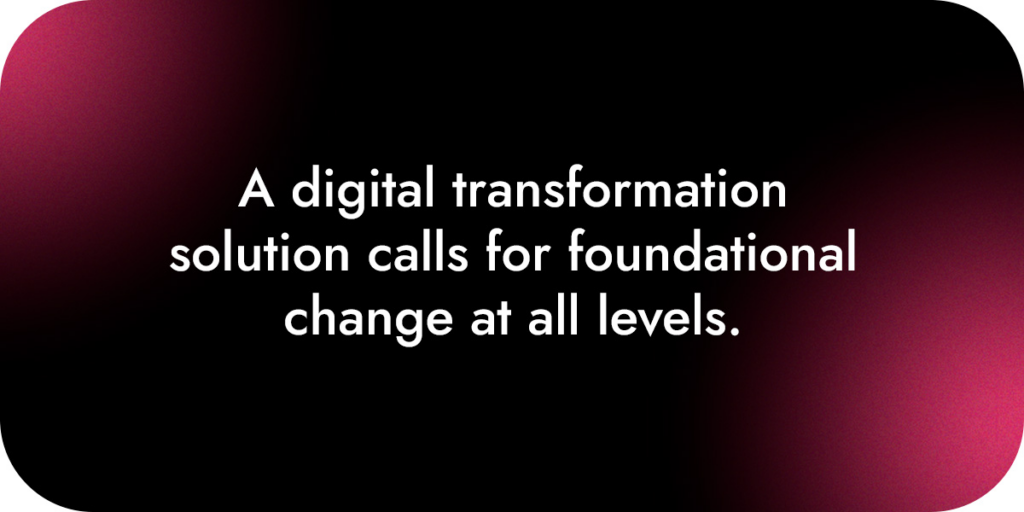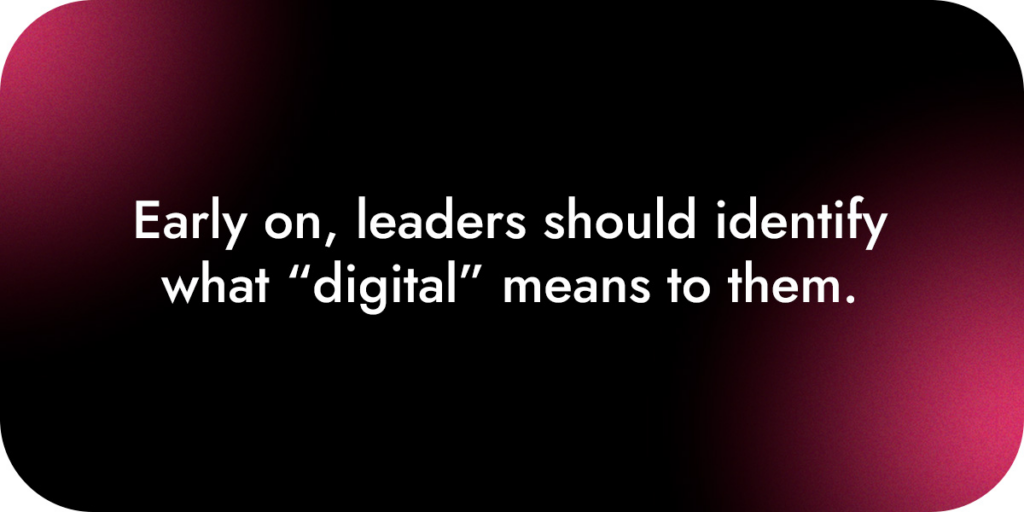
Any business that wants to stay afloat must be ready to adapt or risk falling behind. In the fast-paced age of technology, this evolution often comes in the form of digital transformation. This digital-first strategy guides organizations toward improving processes and delivering more value to customers. It combines new technologies with cultural shifts that promote innovation and continuous adaptation. Regardless of your industry, digital transformation is paving the way forward as a necessity for modern businesses.
What Does Digital Transformation Mean?

To define digital transformation, we have to look at how businesses use their resources. A digital transformation strategy uses technologies to fundamentally change how a business operates and provides value. It may involve a range of goals, like adapting to evolving market conditions or improving your ability to meet customer demands. Whatever the goal, a digital transformation solution calls for foundational change at all levels.
Yet, digital transformation is about more than replacing outdated processes with newer technology — although that step is critical. It’s also about challenging “the way it’s always been” and driving the company toward a more agile mindset with openness to experimentation and innovation. Employees may need to accept the possibility of failure, and companies must embrace new practices before their competitors have already implemented them. Digital transformation rethinks tried-and-true practices and seeks out new methods of continual improvement.
This acceptance of new ideas illustrates the need for both cultural and technological development, hallmarks of a successful digital transformation process.
Another crucial aspect is the lack of a clearly defined endpoint. With a focus on innovation, digital transformation doesn’t end when new software is implemented or your efficiency goals are met. It’s more of a journey about building and maintaining an agile culture. Organizations look for ways to continuously improve the customer experience and operational processes.
Why Is Digital Transformation Important?

Digital transformation is nothing short of crucial for today’s businesses. Technology will continue to evolve, and businesses that embrace transformation will be positioned to use it to meet their goals instead of playing catchup or resisting change.
Even if you don’t feel like you need to change, digital transformation has become a question of resiliency. Adaptation ensures you have the resources and mindset to weather storms and market variations — because your competitors are likely already there.
Even after the initial transformation, you should be able to adopt new technologies as they appear and use them to help meet your business goals. Since we don’t know what the future holds, this agile approach allows organizations to keep pace with uncertainty and innovation, improving customer experiences and operational results with changes that span all parts of the company.
Before tackling a transformation, businesses must understand digital transformation models accurately to implement a strategy that matches their organization. These tactics depend on knowing how digital transformation will apply to a specific business, such as its intended goals and company culture.
The Benefits of Digital Transformation

Although digital transformation is a necessity, it also has many advantages for its users, such as:
- Higher efficiency: Digital technologies facilitate better productivity or reduced labor demands. Automation and artificial intelligence (AI), for instance, are rapidly gaining popularity across business strategies, eliminating manual processes, intelligently solving problems, and allowing skilled employees to focus on more important tasks. Digital transformation technologies are especially good at eliminating repetitive tasks, so your team members can work at the tops of their pay grades.
- Opportunity for innovation: Embracing digital transformation allows you to get ahead of the competition and solidify yourself as a leader in your industry. It supports agility and responsive practices, so you can jump on new technologies, trends, and ideas that help you stand out. For some businesses, a head start makes all the difference in outperforming competitors.
- Improved customer and employee experiences: Both customers and employees expect smooth, seamless resources. Customers want consistent, positive experiences at each touchpoint, while employees want the right tools to help them work their best. These demands are a significant driver for digital transformation strategies and the sophisticated features that come with them.
- Improved communication: Successful digital transformation depends on everyone being on the same page. Many digital strategies provide resources for increasing visibility, transparency, and communication between employees, so this element is a significant part of any digital transformation strategy.
- Risk mitigation: While a more experimental mindset comes with some risk, the digital transformation process can minimize it by providing a more agile position. Digital-first businesses can respond to volatility and disruptions with business models that can pivot as needed.
Keys to a Successful Digital Transformation
Although the goals and nature of digital transformation will vary by company, the following key elements stand out as necessary parts of the equation.
1. Digital Strategies That Empower Workers

Unsurprisingly, digital transformation calls for best-in-class digital tools. These resources should make information accessible across departments, providing cross-functional digital technologies that support efficiency, the customer experience, and other aspects of your transformation goals. Aligning digital strategies with your unique needs can be daunting, so invest special time and energy in finding appropriate resources.
2. New Operational Procedures to Incorporate Digital Technology
Your long-standing operational procedures are likely inappropriate for your new processes. Remember that digital transformation requires fundamental shifts, so new operational procedures will guide workers through the new systems while reflecting these fresh ways of thinking.
3. Engaged and Tech-Savvy Leaders

Digital transformation depends on engaged leaders at all levels being fully invested in the new approach. They should understand the aim of digital transformation and embody the movement during regular communications and activities. These leaders must also have the appropriate technical skills to fully grasp how to integrate new tech and processes into their workflows. Leaders can include executives, supervisors, and even workers chosen to champion the cause.
4. Strong Communication and Collaboration
Any business attempting digital transformation must go all-in. A “halfway” approach is inadequate, so communicating the goals and ideals driving the transformation is critical. You’ll also need to discuss the details, showing team members how these new resources contribute to modernizing the organization. Dive into how the culture shifts support the company’s long-term goals and dedication to the digital approach.
Why Digital Transformations Fail

Despite its importance, the vast majority of digital transformations fail, often due to one of these common pitfalls:
- Poor communication: We mentioned earlier that good communication is key to a successful transformation program, and many of the attempts that don’t succeed involve poor communication. Early on, leaders should identify what “digital” means to them. In one organization, it might mean going paperless, while another might use it to implement agile processes. With so much ambiguity, strong communication is crucial from the highest levels — they should define what the transformation means for the business and how it should happen.
- Inadequate measurement: Like many business strategies, qualitative and quantitative measurements should guide the process. You may already use key performance indicators (KPIs). Continue to use them, and evaluate which ones are most relevant to the digital transformation and create new ones if needed. If your goal, for instance, is to improve the customer experience through a new tech support system, you might pay special attention to your net promoter score. If you’re prioritizing efficiency, ticket resolution speed may be more relevant.
- Culture misalignment: People often equate digital transformation with implementing high-tech tools, but businesses must stress the mindset shift, too. The transformation should include a focus on agility and responsiveness, with ideas that change alongside digital technology. Cultural changes must occur across the organization to help foster innovation and new ideas appropriate for a modern workplace. Many businesses that fail digital transformation do so because they don’t emphasize the cultural change it entails.
Digital Transformation Strategies

Depending on your goals, your digital transformation solution can take on many different forms. Some popular strategies for digital transformation models might focus on:
- Business processes: This kind of digital transformation adjusts the day-to-day workflow and how workers access information. It might involve heavily automating manual processes and gathering reliable and data-driven insights that can guide business decisions. Revising business processes can help you minimize costs, improve product quality, and boost efficiency with faster and more informed procedures.
- Industry domains: If your brand is traditionally limited to one market, you might look to a digital transformation model to help you expand your offerings. A fitness store, for example, could use digital strategies to create a fitness app and sell virtual workouts to appeal to customers and build their brand image. Expanding the boundaries of the brand is a task that often falls to digital transformation.
- Business models: A transformation that affects the entire business model can be drastic but necessary. This approach adapts your current model to a new digital environment, whether that’s an environment you’re creating anew or one that just hasn’t been working well with your old processes. It might call for trying out new ways of operating, even those that no one else in the industry has done yet. In some cases, nailing this transformation disrupts entire industries.
- Culture: Adapting to the digital world is difficult for some people and businesses. A cultural transformation focuses on aligning a company’s culture with the forward-thinking ideas of a digital-first organization. It requires extensive education and training, new onboarding processes, and activities and processes that support collaboration. This type of transformation gives your team the necessary resources to integrate digital technology into every aspect of the workday and maximize its benefits.
- The cloud: A cloud transformation is about moving systems into cloud environments. You may only need it for a few applications or services, or you might move everything. A cloud-based infrastructure helps improve data access and storage, flexibility, and scalability. It offers a more centralized and visible system and can grow alongside your business.
Of course, the lines between these styles of transformation aren’t hard and fast. They often blur and overlap, so identifying what digital transformation strategy is right for your goals and needs can help improve your chances of success.
Digital Transformation Examples
The digital strategies available in different industries often affect the nature of digital transformation and its necessity. Here are a few of the ways that businesses in certain fields or departments might address digital transformation.
1. Health Care

The health care field has seen a dramatic technological transformation. From online check-ins to telehealth appointments, physicians now use digital technology to improve experiences and outcomes across all specialties. At Kaiser Permanente, for instance, about a third of ambulatory care visits in 2022 happened through phone or video calls. Supporting this level of virtual care requires a major shift in infrastructure and mindset.
A health care organization might use digital transformation to better use and integrate new technologies and support clinicians in effectively using these new strategies in their workflow. With capable, easy-to-use systems, health care businesses often improve outcomes and the patient experience while helping providers work more efficiently.
2. Customer Support
As AI and self-service platforms have improved, many businesses with customer support systems have revamped how their customers get help. With digital transformation, a company might reduce the demands on its slow, labor-intensive call center in favor of a support portal for customers to use on their own. Customers might start a return request, track their order, or search through frequent technical issues to troubleshoot the problem in an online knowledge base. The new system can add efficiency while improving the customer experience.
3. Sales and Accounting
Sales and accounting rely on many processes that digital strategies can speed up and refine. A digital transformation in these fields often entails programs that can automate calculations and communications. For example, using traditional spreadsheets for sales tracking would likely lead to errors and slow processes. Moving to a cloud-based system, such as a customer relationship management (CRM) platform, offers efficiency and simplicity. Representatives can easily track interactions, generate quotes, and communicate with clients without time-consuming paperwork.
Get Started With Your Digital Transformation
Digital transformation is a necessity for organizations of all types, offering the agility and modern resources required to compete in today’s business environment. Still, it involves a dedicated, concerted effort with the right kind of talent guiding the charge. You need everything from software engineers to data scientists and brand strategists. At Kopius, Inc., we’ll help you assemble the right team and solidify a successful program with our digital transformation services.
We offer dual-shore digital expertise with end-to-end capabilities to support speedy, effective digital transformations. From our lean, agile roadmaps to our data and analytical services, we provide flexible yet streamlined strategies tailored to your organization’s unique demands. Reach out to us today to discuss your needs and start on the path to digital transformation!

Additional Resources: